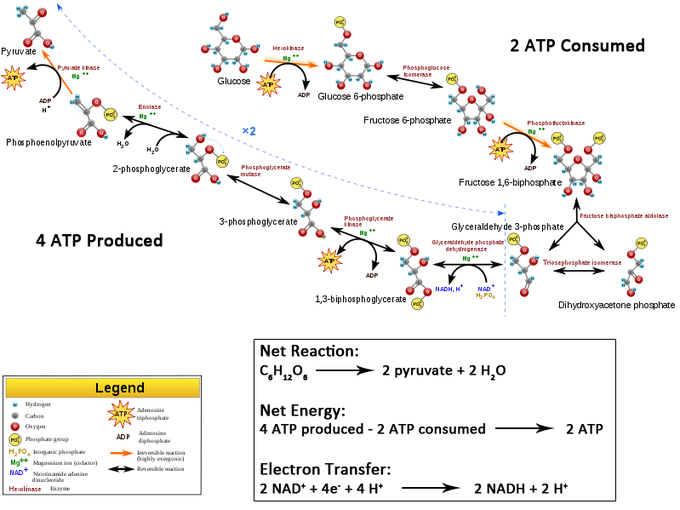7.7: Glycolysis - Outcomes of Glycolysis
- Page ID
- 13146
- Describe the energy obtained from one molecule of glucose going through glycolysis
Outcomes of Glycolysis
Glycolysis starts with one molecule of glucose and ends with two pyruvate (pyruvic acid) molecules, a total of four ATP molecules, and two molecules of NADH. Two ATP molecules were used in the first half of the pathway to prepare the six-carbon ring for cleavage, so the cell has a net gain of two ATP molecules and 2 NADH molecules for its use. If the cell cannot catabolize the pyruvate molecules further (via the citric acid cycle or Krebs cycle), it will harvest only two ATP molecules from one molecule of glucose.

Mature mammalian red blood cells do not have mitochondria and are not capable of aerobic respiration, the process in which organisms convert energy in the presence of oxygen. Instead, glycolysis is their sole source of ATP. Therefore, if glycolysis is interrupted, the red blood cells lose their ability to maintain their sodium-potassium pumps, which require ATP to function, and eventually, they die. For example, since the second half of glycolysis (which produces the energy molecules) slows or stops in the absence of NAD+, when NAD+ is unavailable, red blood cells will be unable to produce a sufficient amount of ATP in order to survive.
Additionally, the last step in glycolysis will not occur if pyruvate kinase, the enzyme that catalyzes the formation of pyruvate, is not available in sufficient quantities. In this situation, the entire glycolysis pathway will continue to proceed, but only two ATP molecules will be made in the second half (instead of the usual four ATP molecules). Thus, pyruvate kinase is a rate-limiting enzyme for glycolysis.
Key Points
- Although four ATP molecules are produced in the second half, the net gain of glycolysis is only two ATP because two ATP molecules are used in the first half of glycolysis.
- Enzymes that catalyze the reactions that produce ATP are rate-limiting steps of glycolysis and must be present in sufficient quantities for glycolysis to complete the production of four ATP, two NADH, and two pyruvate molecules for each glucose molecule that enters the pathway.
- Red blood cells require glycolysis as their sole source of ATP in order to survive, because they do not have mitochondria.
- Cancer cells and stem cells also use glycolysis as the main source of ATP (process known as aerobic glycolysis, or Warburg effect).
Key Terms
- pyruvate: any salt or ester of pyruvic acid; the end product of glycolysis before entering the TCA cycle
Contributions and Attributions
- OpenStax College, Biology. October 16, 2013. Provided by: OpenStax CNX. Located at: http://cnx.org/content/m44432/latest...ol11448/latest. License: CC BY: Attribution
- heterotroph. Provided by: Wiktionary. Located at: en.wiktionary.org/wiki/heterotroph. License: CC BY-SA: Attribution-ShareAlike
- glycolysis. Provided by: Wiktionary. Located at: en.wiktionary.org/wiki/glycolysis. License: CC BY-SA: Attribution-ShareAlike
- OpenStax College, Carbohydrate Metabolism. November 10, 2013. Provided by: OpenStax CNX. Located at: http://cnx.org/content/m46451/latest/. License: CC BY: Attribution
- OpenStax College, Biology. October 16, 2013. Provided by: OpenStax CNX. Located at: http://cnx.org/content/m44432/latest...ol11448/latest. License: CC BY: Attribution
- glucose. Provided by: Wiktionary. Located at: en.wiktionary.org/wiki/glucose. License: CC BY-SA: Attribution-ShareAlike
- adenosine triphosphate. Provided by: Wikipedia. Located at: en.Wikipedia.org/wiki/adenosine%20triphosphate. License: CC BY-SA: Attribution-ShareAlike
- OpenStax College, Carbohydrate Metabolism. November 10, 2013. Provided by: OpenStax CNX. Located at: http://cnx.org/content/m46451/latest/. License: CC BY: Attribution
- OpenStax College, Glycolysis. October 16, 2013. Provided by: OpenStax CNX. Located at: http://cnx.org/content/m44432/latest...e_07_02_01.jpg. License: CC BY: Attribution
- OpenStax College, Biology. October 16, 2013. Provided by: OpenStax CNX. Located at: http://cnx.org/content/m44432/latest/?collection=col11448/latest. License: CC BY: Attribution
- NADH. Provided by: Wiktionary. Located at: en.wiktionary.org/wiki/NADH. License: CC BY-SA: Attribution-ShareAlike
- OpenStax College, Carbohydrate Metabolism. November 10, 2013. Provided by: OpenStax CNX. Located at: http://cnx.org/content/m46451/latest/. License: CC BY: Attribution
- OpenStax College, Glycolysis. October 16, 2013. Provided by: OpenStax CNX. Located at: http://cnx.org/content/m44432/latest...e_07_02_01.jpg. License: CC BY: Attribution
- OpenStax College, Glycolysis. October 16, 2013. Provided by: OpenStax CNX. Located at: http://cnx.org/content/m44432/latest...e_07_02_02.jpg. License: CC BY: Attribution
- OpenStax College, Biology. October 16, 2013. Provided by: OpenStax CNX. Located at: http://cnx.org/content/m44432/latest/?collection=col11448/latest. License: CC BY: Attribution
- pyruvate. Provided by: Wiktionary. Located at: en.wiktionary.org/wiki/pyruvate. License: CC BY-SA: Attribution-ShareAlike
- OpenStax College, Carbohydrate Metabolism. November 10, 2013. Provided by: OpenStax CNX. Located at: http://cnx.org/content/m46451/latest/. License: CC BY: Attribution
- OpenStax College, Glycolysis. October 16, 2013. Provided by: OpenStax CNX. Located at: http://cnx.org/content/m44432/latest...e_07_02_01.jpg. License: CC BY: Attribution
- OpenStax College, Glycolysis. October 16, 2013. Provided by: OpenStax CNX. Located at: http://cnx.org/content/m44432/latest...e_07_02_02.jpg. License: CC BY: Attribution
- Glycolysis. Provided by: Wikipedia. Located at: en.Wikipedia.org/wiki/File:Glycolysis.svg. License: CC BY-SA: Attribution-ShareAlike


